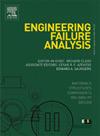不同热处理温度下 TA2-Q345 爆炸复合板的腐蚀性能评估
IF 5.7
2区 工程技术
Q1 ENGINEERING, MECHANICAL
引用次数: 0
摘要
本研究探讨了在 500 ℃、600 ℃、700 ℃ 和 800 ℃ 下进行焊后热处理 (PWHT) 对 TA2-Q345 爆炸复合板(以 TA2 为飞边板,Q345 为基板)的微观结构和腐蚀性能的影响。在进行电化学实验的同时,还进行了 X 射线衍射(XRD)、光学显微镜(OM)、扫描电子显微镜(SEM)和能量色散光谱(EDS)分析。TA2-Q345 复合板的爆炸焊接界面呈现出特有的波浪状结构,表明焊接质量很高。XRD 结果表明,PWHT 温度会显著影响氧化膜的相结构和衍射峰强度。此外,孔隙率计算表明,在 500 °C 下进行 PWHT 的样品表面氧化膜的孔隙率最低,因此氧化膜更致密,有效提高了耐腐蚀性。然而,随着温度的不断升高,氧化膜和钛基体之间出现了凹坑、凸起和分层等缺陷。电化学分析结果表明,与未处理的样品相比,PWHT 样品的耐腐蚀性能有所提高。具体来说,在 500 °C 下进行 PWHT 的样品的腐蚀电流密度(icorr)最低,为 6.1892E-06 A/cm2,而未经处理的样品的腐蚀电流密度(icorr)最高,为 6.3577E-05 A/cm2,这表明 500 °C 是最佳温度。腐蚀过程包括氯化钛水解形成 TiO2 膜以及 TiO2 保护膜的局部腐蚀。主要由 C、O 和 Ti 组成的腐蚀产物分散在 PWHT 样品的表面。本文章由计算机程序翻译,如有差异,请以英文原文为准。
Evaluation of corrosion properties of TA2-Q345 explosive composite plate at different heat treatment temperatures
This study investigated the effects of post-weld heat treatment (PWHT) at 500 °C, 600 °C, 700 °C, and 800 °C on the microstructure and corrosion performance of the TA2-Q345 explosive composite plate, with TA2 as the flyer plate and Q345 as the base plate. X-ray diffraction (XRD), optical microscopy (OM), scanning electron microscopy (SEM), and energy dispersive spectroscopy (EDS) analyses were performed, alongside electrochemical experiments. The explosive welding interface of the TA2-Q345 composite plate exhibited a characteristic wavy structure, which indicated high welding quality. The XRD results indicated that the PWHT temperature significantly affects both the phase structure and the intensity of the diffraction peaks of the oxide film. Additionally, the porosity calculations demonstrated that the sample subjected to PWHT at 500 °C exhibited the lowest porosity in the surface oxide film, resulting in a denser oxide film that effectively enhanced corrosion resistance. However, as the temperature continued to rise, defects such as craters, bulges, and delamination between the oxide film and the titanium matrix were observed. The results of the electrochemical analysis indicated that, compared to untreated samples, the PWHT samples demonstrated improved corrosion resistance. Specifically, the sample with PWHT at 500 °C has the lowest corrosion current density (icorr) of 6.1892E-06 A/cm2, while the untreated sample has the highest icorr of 6.3577E-05 A/cm2, indicating that 500 °C is the optimal temperature. The corrosion process involved the hydrolysis of titanium chloride to form a TiO2 film and localized corrosion of the TiO2 protective film. The corrosion products composed of mainly C, O, and Ti were dispersed on the surface of PWHT samples.
求助全文
通过发布文献求助,成功后即可免费获取论文全文。
去求助
来源期刊

Engineering Failure Analysis
工程技术-材料科学:表征与测试
CiteScore
7.70
自引率
20.00%
发文量
956
审稿时长
47 days
期刊介绍:
Engineering Failure Analysis publishes research papers describing the analysis of engineering failures and related studies.
Papers relating to the structure, properties and behaviour of engineering materials are encouraged, particularly those which also involve the detailed application of materials parameters to problems in engineering structures, components and design. In addition to the area of materials engineering, the interacting fields of mechanical, manufacturing, aeronautical, civil, chemical, corrosion and design engineering are considered relevant. Activity should be directed at analysing engineering failures and carrying out research to help reduce the incidences of failures and to extend the operating horizons of engineering materials.
Emphasis is placed on the mechanical properties of materials and their behaviour when influenced by structure, process and environment. Metallic, polymeric, ceramic and natural materials are all included and the application of these materials to real engineering situations should be emphasised. The use of a case-study based approach is also encouraged.
Engineering Failure Analysis provides essential reference material and critical feedback into the design process thereby contributing to the prevention of engineering failures in the future. All submissions will be subject to peer review from leading experts in the field.
 求助内容:
求助内容: 应助结果提醒方式:
应助结果提醒方式:


